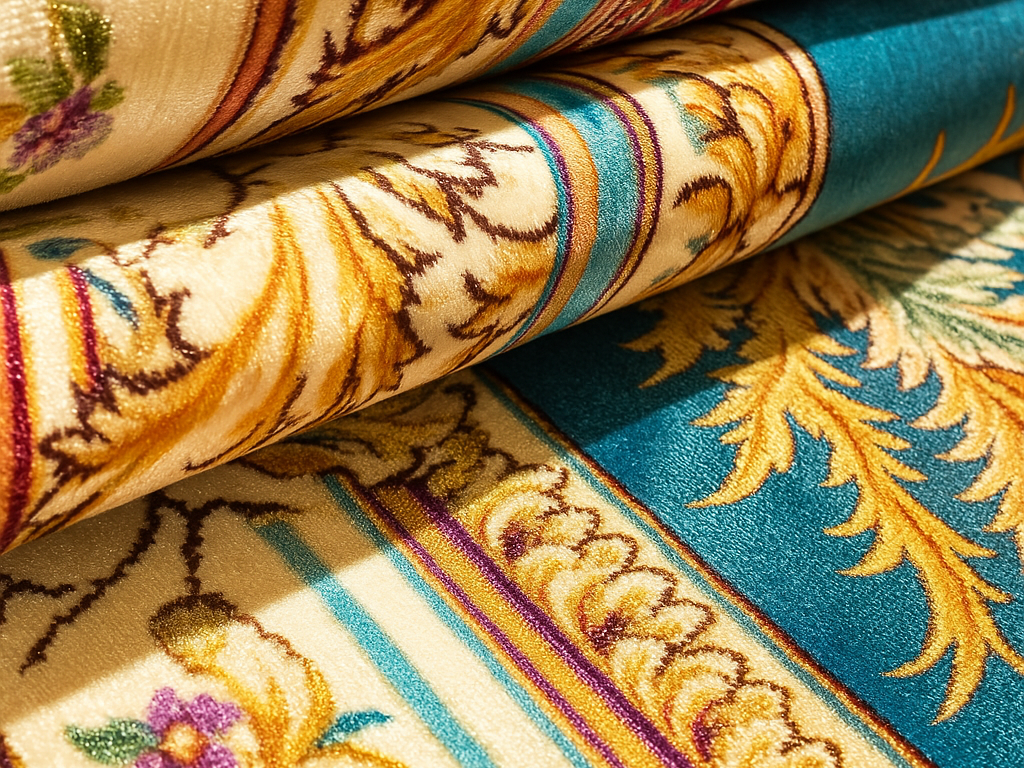호텔 층에서 조용히 고객 만족을 방해하고 있나요? 2025년에 적합한 호텔 카펫은 단순히 발자국을 흡수하는 것 이상의 역할을 하며 편안함, 브랜드 정체성, 음향 및 안전에 대한 분위기를 조성합니다. 이 가이드에서는 카펫 유형과 업계 표준부터 호텔 및 상업 공간에 맞는 실용적인 소싱 및 유지 관리 팁까지 모든 것을 살펴볼 수 있습니다.
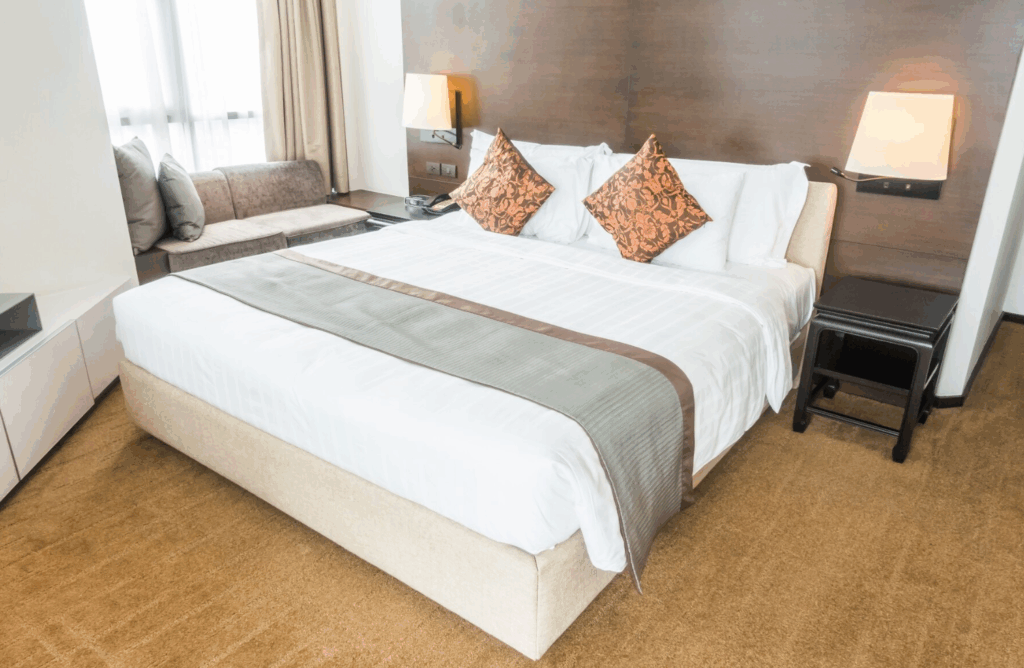
다음 섹션에서는 이에 대해 자세히 설명합니다:
- 벽에서 벽까지 이어지는 카펫과 모듈형 타일의 차이점
- 터프티드, 우븐, 니들 펀칭 구조 중 선택 가능
- 알아야 할 규정 준수 아이콘 및 화재 등급 인증
- 그리고 양질의 제조업체를 찾고 카펫을 최적의 상태로 유지하기 위한 단계별 로드맵을 확인하세요.
이 포스팅을 마치면 숙박 시설 등급 카펫을 자신 있게 선택, 설치 및 유지 관리하여 내구성, 디자인, 게스트 경험 면에서 돋보이는 숙소를 운영할 수 있게 됩니다. 지금 바로 시작하겠습니다.
1. 호스피탈리티 카펫의 이해
호스피탈리티 카펫은 단순한 바닥재 그 이상으로 미적 감각, 편안함, 내구성, 브랜딩이 조화를 이룬 제품입니다. 호텔, 리조트, 레스토랑과 같이 유동인구가 많은 상업 환경을 위해 특별히 설계된 이 카펫은 지속적인 사용을 견디면서도 따뜻하고 친근한 분위기를 제공하도록 설계되었습니다.
주거용 카펫과 달리 호텔 등급 옵션은 수명, 얼룩 방지, 유지 관리의 용이성, 화재 안전성을 우선시합니다. 또한 고급 호텔의 화려하고 플러시한 스타일부터 모던 부티크 숙박시설의 미니멀하고 기능적인 디자인까지 브랜드의 개성을 반영합니다.
관련 읽기: 사무실 러그: 사무실 카펫에 대한 궁극적인 가이드
2. 카펫 대 하드 바닥재: 호텔에 필요한 이유 카펫
호텔리어가 카펫, 원목, LVT, 타일, 광택 콘크리트 등 바닥재 옵션을 고려할 때, 선택은 종종 균형 잡힌 선택으로 귀결됩니다. 게스트의 편안함, 음향, 미학, 비용, 유지보수 및 안전 보장. 카펫을 쌓는 방법은 다음과 같습니다:
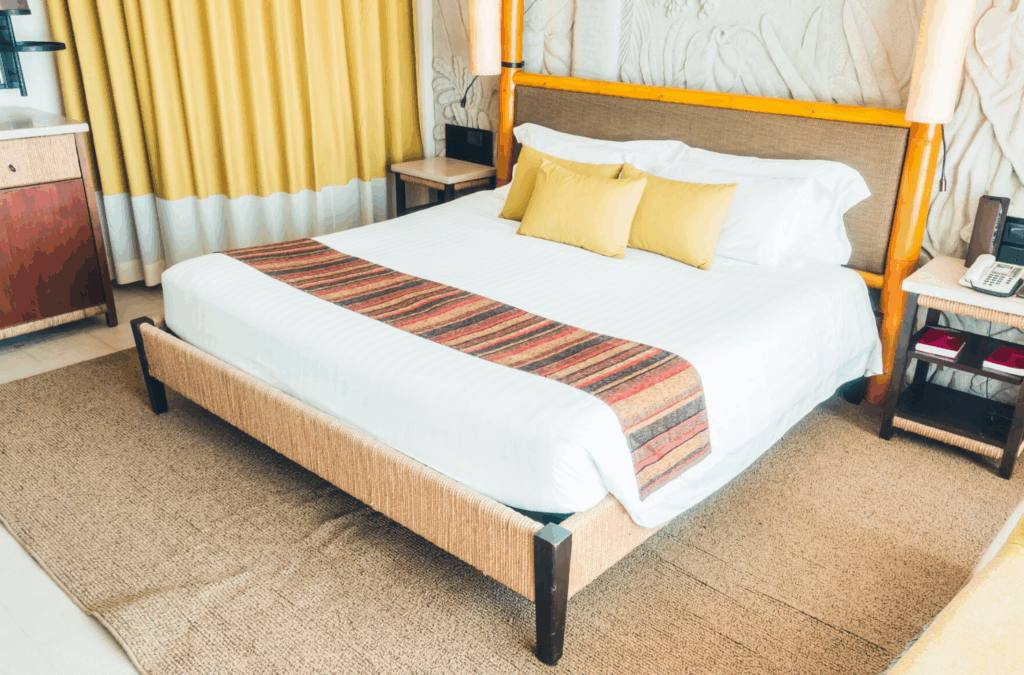
음향적 편안함 및 소음 감소
- 뛰어난 흡음: 카펫 섬유가 음파를 자연스럽게 가두고 감쇠시켜 하드 바닥에 비해 에코와 주변 소음을 최대 30%까지 줄여줍니다.
- 충격 소음 제어: 카펫 위를 밟을 때마다 소음이 현저히 줄어들어 복도나 저층으로 소리가 전달되지 않아 호텔 투숙객과 직원 모두 매우 만족하는 경험입니다.
복도, 회의실, 객실 등 평온함이 중요한 공간에서 카펫은 단순한 장식이 아니라 최고 수준의 서비스를 달성하기 위한 전략적 요소입니다. 노이즈 감소 계수(NRC) 그리고 충격 절연 등급(IIC) 점수.
따뜻함 & 게스트의 편안함
- 발밑의 부드러움: 카펫은 자연스럽게 쿠션감이 있고 아늑한 표면을 만들어 객실과 라운지의 편안함을 즉각적으로 높여줍니다.
- 단열: 돌이나 타일보다 열을 더 잘 유지하며 실내 온도가 10~20°F 더 따뜻하게 느껴져 추운 기후나 계절에 매우 중요합니다.
촉각적, 환경적 편안함은 호텔 업계에서 타협할 수 없는 요소이며, 카펫은 이를 제공합니다.
디자인 유연성 및 브랜딩
- 시각적 다양성: 대담한 기하학부터 미묘한 질감, 맞춤형 로고까지 카펫은 사실상 무한한 창의성을 지원합니다. 염료 주입 기술과 같은 발전으로 맞춤형 디자인을 더 빠르고 비용 효율적으로 제작할 수 있습니다.
- 브랜드 강화: 브랜드 색상과 패턴을 카펫 디자인에 통합하는 것은 게스트의 여정 전반에 걸쳐 정체성을 강화하는 효과적이면서도 미묘한 방법입니다.
하드 바닥재는 트렌드 중심의 시각적 효과에는 탁월할 수 있지만, 진정한 몰입형 디자인에는 카펫이 유리합니다.
비용 및 수명 주기 가치
- 설치 및 교체: 카펫은 설치 비용이 저렴하고 구간별로 쉽게 교체할 수 있어 교통량이 많은 구역에 이상적입니다.
- 장기적인 내구성: 고급 호텔 카펫(터프프 또는 프리미엄 직조 포함)은 적절히 관리하면 10~30년 동안 사용할 수 있어 실질적인 ROI를 제공합니다.
하드 바닥재는 시간이 지남에 따라 가격이 저렴해 보일 수 있지만 음향, 편안함, 맞춤형 업그레이드로 인해 숙박 시설에서 더 많은 비용이 발생하는 경우가 많습니다.
유지 관리 및 위생
- 현대적인 내구성: 오늘날의 카펫은 얼룩과 습기에 강하도록 처리되어 살균과 관리가 더 쉬워졌습니다.
- 정기 관리: 매일 진공 청소기, 스팟 청소, 주기적인 딥 클리닝(저습 추출 또는 온수 방식)으로 카펫을 손님맞이 준비 상태로 유지합니다.
딱딱한 바닥은 걸레질하기 쉽지만, 먼지 구석구석까지 보이기도 하고 특히 밤에 잠에서 깰 때 발밑이 차갑고 덜 포근하게 느껴질 수 있습니다.
안전 및 미끄럼 방지
- 미끄러짐 위험 감소: 카펫 바닥은 접지력을 제공하여 미끄러짐과 낙상을 크게 줄여주며 특히 수영장 구역, 회의실, 게스트 스위트 근처에서 유용합니다.
- 완충된 충격: 패딩은 낙상 시 딱딱한 표면보다 부드럽게 착지할 수 있어 안전 및 보험상의 이유로 중요합니다.
딱딱한 바닥재가 여전히 합리적일 때
LVT 또는 타일과 같은 단단한 표면은 다음과 같은 분야에서 여전히 인기가 있습니다. 욕실, 체육관, 스파 및 조식 공간, 에서 방수 및 빠른 청소 를 우선시합니다. 그러나 많은 고급 숙소는 에어리어 러그로 경도를 완화하거나 두 가지 유형을 혼합하여 기능성과 편안함을 모두 충족합니다.
관련 읽기: 프린트 러그와 터프티드 러그 비교: 선택 방법
3. 벽부터 바닥까지 깔개 대 카펫 타일
호텔 바닥재를 계획할 때 중요한 결정 중 하나는 다음과 같습니다. 벽부터 바닥까지 넓은 카펫 그리고 모듈형 카펫 타일. 각 옵션은 설계 목표, 유지 관리 전략 및 예산에 따라 뚜렷한 이점을 제공합니다. 대부분의 경우 하이브리드 접근 방식이 최상의 결과를 제공합니다.
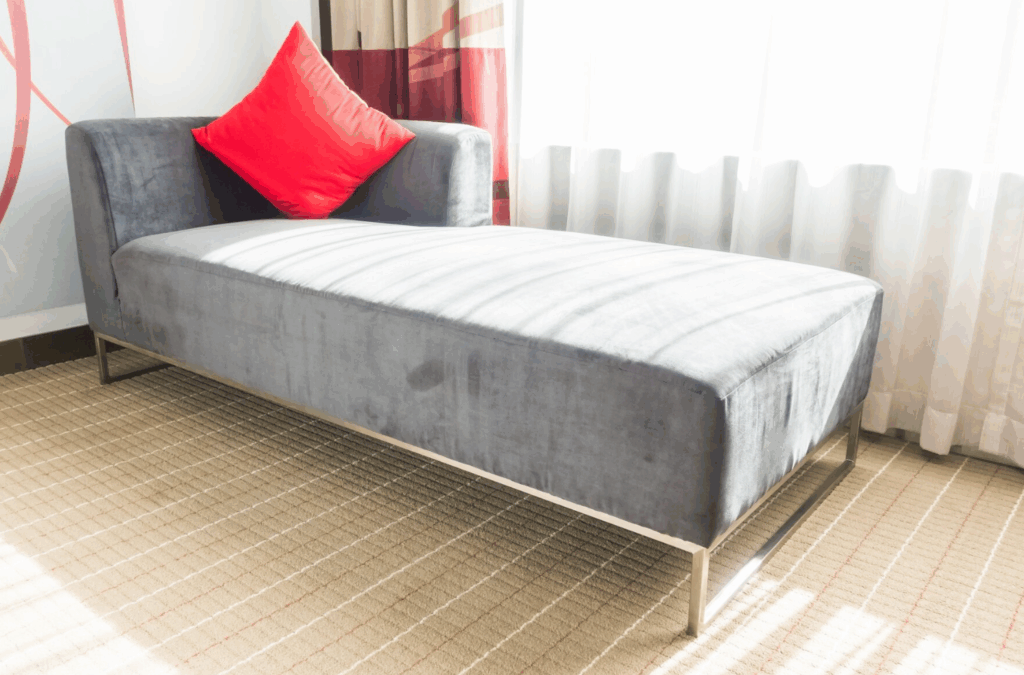
시각 및 발밑 경험
- 벽부터 바닥까지 이어지는 카펫: 고급스럽고 매끄러운 미적 감각을 제공하며 발밑에 닿는 촉감이 좋습니다. 중단 없는 시각 및 촉각 경험이 중요한 고급 스위트룸, 연회장, 복도에 이상적입니다.
- 카펫 타일: 제조 기술의 발전으로 이음새가 거의 없어 보이지만, 대부분은 여전히 약간의 이음새가 보이고 두꺼운 언더패드가 없으면 단단한 느낌을 줍니다. 편안함은 괜찮지만 푹신하지는 않습니다.
디자인 팁: 고급스러운 브랜딩과 몰입형 디자인을 원한다면 브로드룸이 제격입니다. 타일은 캐주얼한 공간이나 유동인구가 많은 공간에서 창의적인 구역 설정과 재미있는 패턴을 연출하는 데 적합합니다.
설치 복잡성 및 비용
선불 비용
- 벽에서 벽까지의 파이버 롤은 일반적으로 다음과 같은 비용이 듭니다. $2-$5/평방 피트, 전문 설치를 위한 $1-$3을 추가합니다. .
- 카펫 타일의 범위는 다음과 같습니다. $1-$6/평방 피트, 를 사용하여 효율적으로 접착식 또는 DIY 설치가 가능하여 인건비를 절감할 수 있습니다.
설치 낭비 및 시간
- 브로드룸을 설치하면 다음이 생성됩니다. 5-25% 폐기물 방의 형태에 따라 다르며 노동 집약적인 작업입니다.
- 타일 생성 단 1-3% 낭비, 는 비전문가도 쉽고 빠르게 설치할 수 있습니다.
유지 관리 및 수리
벽에서 벽까지 카펫 손상에 대한 현장 수리 또는 패치가 필요한 경우 전문가의 도움을 받아야 합니다.
카펫 타일, 와는 대조적입니다:
- 얼룩이 지거나 마모된 타일을 여분의 타일로 신속하게 교체할 수 있습니다.
- 모듈식 교체로 다운타임과 인건비를 크게 줄일 수 있습니다.
교통 혼잡 지역에 대한 내구성 및 적합성
고밀도 백킹 및 고성능 섬유를 사용한 고품질 타일은 다음을 위해 설계되었습니다. 높은 트래픽 복원력, 보통 10~20년으로 평가됩니다.
브로드룸은 액스민스터나 윌튼과 같은 프리미엄 섬유로 제공되지만 패딩이 필요할 수 있으며, 정기적으로 관리하지 않으면 바쁜 구역에서 마모가 나타날 수 있습니다.
관련 읽기: 러그도 가구로 간주되나요? 완벽한 인테리어 디자인 분석
4. 터프티드, 우븐 또는 니들 펀칭 카펫: 어떤 것이 가장 좋을까요?
호스피탈리티 카펫을 지정할 때 세 가지 주요 시공 방법을 이해해야 합니다.터프티드, woven및 바늘 구멍 뚫기-가 중요합니다. 각 방법은 내구성, 심미성, 비용 및 기능 측면에서 서로 다른 요구 사항을 충족합니다.
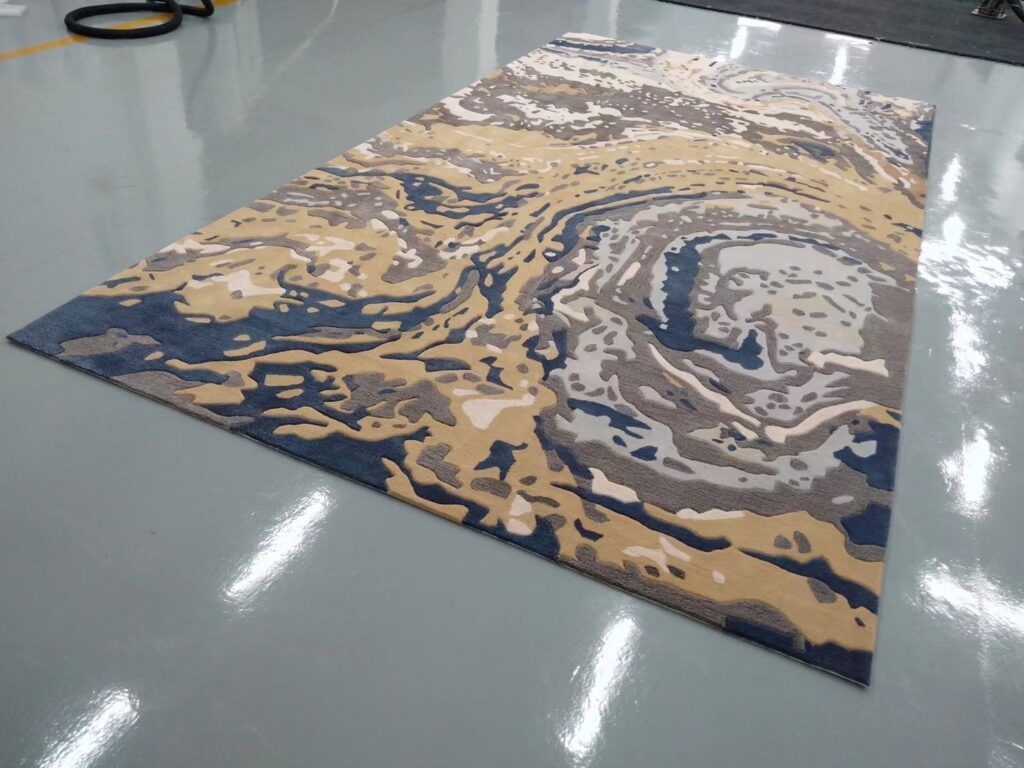
터프티드 카펫: 다용도 및 비용 효율적
터프프티드 카펫 는 빠른 생산, 비용 효율성 및 디자인 다양성 덕분에 상업용 바닥의 약 95%를 차지할 정도로 호스피탈리티 분야에서 가장 인기 있는 선택입니다.
건설
원사 고리를 1차 뒷면에 펀칭한 다음 라텍스로 고정하고 황마나 천과 같은 2차 재료로 뒷면을 받칩니다.
장점
- 예산 친화적: 기계 기반의 빠른 생산으로 카펫을 더 저렴하게 만들 수 있습니다.
- 사용자 지정 가능한 미학: 다양한 패턴, 파일 높이(루프 또는 컷), 다양한 질감으로 제공됩니다.
- 간단한 설치 및 수리: 터프티드 와이드 룸은 쉽게 솔기 처리할 수 있으며 터프티드 타일은 종종 모듈식으로 빠르게 교체할 수 있습니다.
고려 사항
- 내구성: 우븐보다 낮지만 고밀도 백킹과 견고한 섬유 사양으로 고성능 옵션이 가능합니다. .
- 셰딩: 설치 후 느슨한 섬유가 나타날 수 있지만 시간이 지남에 따라 감소합니다.
이상적인 용도: 객실, 중간급 이벤트 공간, 프리미엄 비용 없이 다양한 디자인을 우선시하는 공간.
우븐 카펫: 내구성 및 고급스러움
카펫처럼 짠 Axminster 또는 Wilton-전통적으로 그랜드 스위트룸과 웅장한 공용 공간 등 최고급 호텔 시설과 연관되어 있습니다.
건설
윗면과 뒷면의 실을 동시에 인터레이스하여 직기에서 생산하여 매끄럽고 촘촘한 직물을 만듭니다.
장점
- 탁월한 수명: 우븐 카펫은 20~30년 동안 사용할 수 있어 장기적인 투자가 가능합니다.
- 풍부한 미적 디테일: 컷 루프 조합을 포함한 복잡한 패턴과 풍부한 텍스처에 이상적입니다.
- 마모 및 흘림 최소화: 뛰어난 구조적 무결성으로 파일 손실을 최소화하고 외관을 장기간 유지할 수 있습니다.
고려 사항
- 높은 비용 및 리드 타임: 직조기 기반 생산은 더 느리고 비용이 많이 듭니다.
- 복잡한 설치: 전문가가 필요하며, 대량으로 인해 폐기물과 설치 노동력이 증가합니다.
이상적인 용도: 호텔 연회장, 시그니처 스위트룸, 부티크 로비, 유서 깊은 장소 등 고급스러운 공간에서 고급스러움과 우아함을 추구하는 곳입니다.
니들 펀칭 카펫: 견고하고 기능적인 카펫
부직포 또는 니들펀치 카펫이라고도 하는 이 방식은 섬유를 펠트와 같은 매트에 기계적으로 묶어 견고한 내구성으로 유명합니다.
건설
직기나 터프팅 건 없이 펠트 섬유를 반복적으로 맞물리게 합니다. 그 결과 조밀하게 실로 결합된 표면이 만들어집니다.
장점
- 견고함을 위한 설계: 내마모성이 뛰어나 상업적 사용이 많은 장소에 이상적입니다.
- 비용 효율적이고 빠른: 효율적인 생산으로 가격 경쟁력을 확보하고, 무게가 가벼워 설치가 용이합니다.
- 기능적 다양성: 방수 및 난연성 버전으로 제공되며 임시 낙하산, 이벤트 무대 또는 야외 입구에 이상적입니다.
고려 사항
- 편안하고 세련된 디자인: 텍스처는 다른 카펫 유형에 비해 푹신한 느낌이 부족하고, 디자인은 사용자 지정 옵션이 적습니다.
- 기본 미학: 고급스러운 비주얼을 지향하는 것이 아니라 장식보다는 실용성을 중시합니다.
이상적인 용도: 집 뒤편 공간, 이벤트 홀, 팝업 전시회, 실용성이 안락함보다 중요한 장소.
어떤 것을 선택해야 할까요?
해답은 성능, 외관, ROI를 조화시키는 데 있습니다:
- 고급스러움과 긴 수명을 위해: 투자 대상 woven-유행을 타지 않고 우아하며 오래 사용할 수 있도록 제작되었습니다.
- 설계 적응성 및 비용 관리: 선택 터프티드, 특히 얼룩에 강한 용액 염색 버전은 더욱 그렇습니다.
- 실용적인 내구성: 선택 바늘 구멍 뚫기 트래픽이 많거나 유출되기 쉬운 구역에서 사용하세요.
잘 계획된 혼합(스위트룸에 터프팅, 시그니처 공간에 우븐, 실용적인 공간에 니들 펀칭)을 통해 다음과 같은 최적의 조합을 제공할 수 있습니다. 디자인 일관성, 게스트의 편안함및 운영 효율성.
5. 올바른 호스피탈리티 카펫을 선택하는 방법
올바른 호스피탈리티 카펫 선택하기 공간의 사용 방식을 이해하는 것부터 시작합니다. 로비나 복도와 같이 통행량이 많은 공간에는 내마모성과 얼룩 내구성이 뛰어난 나일론 소재가 적합하고, 통행량이 적은 공간에는 고급스러운 느낌을 주는 프리미엄 울 또는 울-나일론 혼방 소재를 선택하는 것이 좋습니다. 카펫 “온스”(면 무게) 및 내마모성 등급을 확인하세요. 무게가 무겁고 섬유 뒷면이 강화된 제품은 까다로운 환경에서 카펫의 수명이 크게 연장됩니다. 파일 높이가 적절한지 확인: 저파일에서 중간 파일 카펫은 청소가 간편하고 바쁜 공간에서 보다 효과적으로 깔끔한 외관을 유지하며, 객실과 스위트룸에는 더 높은 파일 옵션을 예약하여 편안함을 높일 수 있습니다.
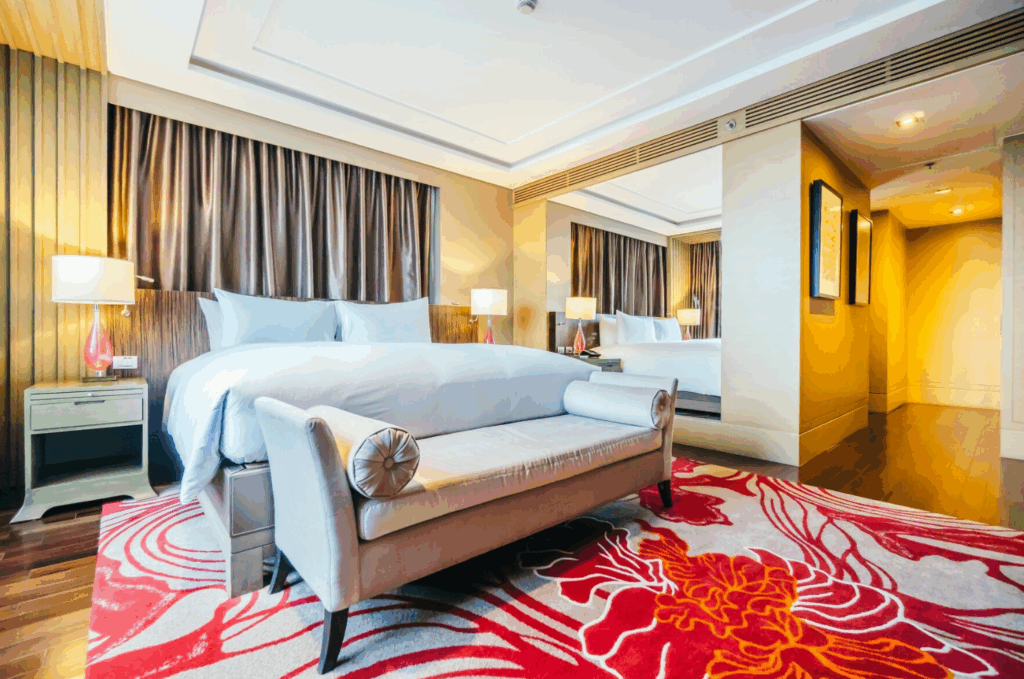
다음으로, 성능 표준과 미적 목표에 맞춰 제품을 선택하세요. 내구성을 위한 EN 1307, 안전을 위한 ASTM 또는 ISO 화재 등급, 실내 공기질을 위한 CRI 그린 라벨 플러스와 같은 업계 인증을 준수하는지 확인하여 규정을 준수하고 안심할 수 있도록 하세요. 패턴이 풍부하거나 맞춤 염색된 카펫은 브랜드를 강화하고 먼지를 숨길 수 있으며, 뉴트럴 톤은 유행을 타지 않는 매력과 다용도로 사용할 수 있는 디자인 유연성을 고려하세요. 마지막으로, 실제 조명 조건에서 대형 견본과 테스트 샘플을 요청하고 강력한 보증, 얼룩 방지 처리 및 유지보수 지원을 제공하는 공급업체와 협력하여 이러한 계층적 접근 방식을 통해 최종 카펫이 성능, 스타일 및 장기적인 가치를 제공하도록 보장합니다.
6. 호스피탈리티 카펫을 이용한 음향학
숙박업에서 방음은 매우 중요합니다. 카펫은 관리에 있어 중추적인 역할을 합니다:
- 충격 소음: 발자국, 떨어뜨린 물건.
- 공기 중 소음: 대화, TV, 복도 소리.
조밀한 언더레이가 있는 두꺼운 카펫은 데시벨 전달을 크게 줄입니다. 특히 다층 건물에서 카펫이 깔린 바닥은 우수한 NRC(노이즈 감소 계수) 그리고 IIC(충격 절연 등급) 점수.
로비나 레스토랑과 같은 공간에 음향 러그를 추가하면 디자인을 손상시키지 않으면서도 도움이 될 수 있습니다.
7. 호스피탈리티 카펫 표준 이해
호텔용 카펫은 다양한 국제 표준을 충족해야 합니다. 살펴봐야 할 주요 인증:
- CRI 그린 라벨 플러스: VOC 배출량이 적음을 나타냅니다.
- ASTM D2859: 가연성 기준(알약 테스트).
- EN 1307: 분류 및 성능에 대한 유럽 표준.
- ISO 9239-1: 복사열에서의 화재 행동.
- GUT(독일): 환경 및 건강 기준.
전문가 팁: 테스트 결과 및 규정 준수 정보가 포함된 기술 데이터 시트(TDS)는 제품을 완성하기 전에 항상 요청하세요.
8. 카펫 선택 시 호스피탈리티 카펫의 상징
카펫 제품 정보나 견본을 검토할 때 호텔 및 호스피탈리티 요구사항에 부합하는 성능 속성을 빠르게 전달하는 작은 아이콘 기호를 자주 볼 수 있습니다. 이러한 표준화된 기호(특히 유럽에서는 FCSS 및 EN 표준을 통해)는 다양한 환경에 대한 적합성에 대한 명확한 시각적 단서를 제공합니다:
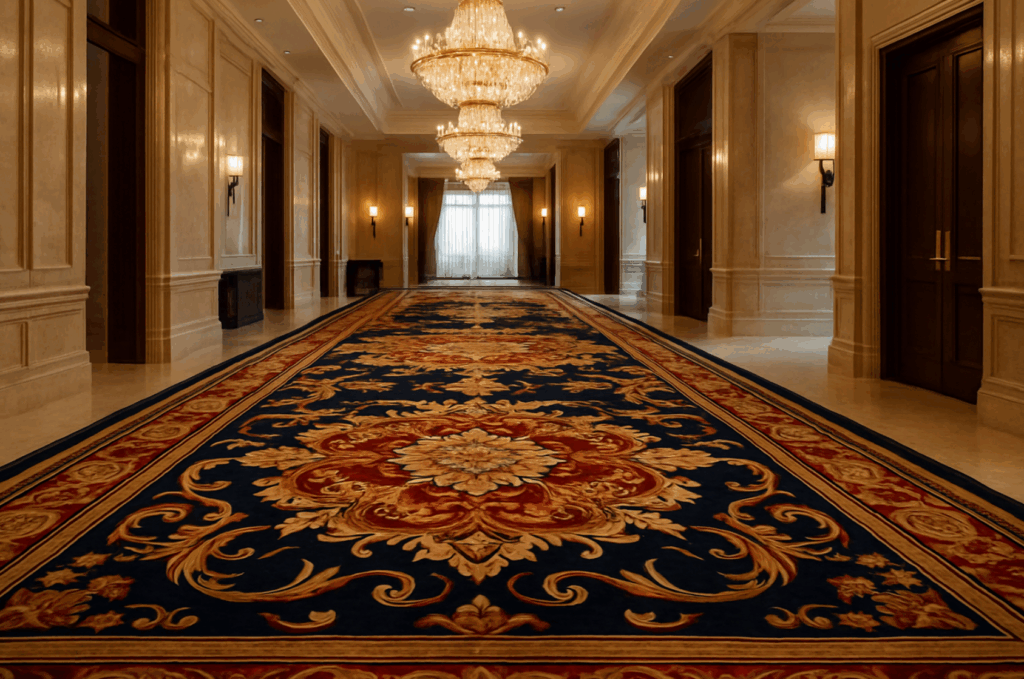
교통 및 럭셔리 클래스
다음과 같은 숫자가 있는 기호 31, 32, 33 상업적 적합성을 나타냅니다:
- 31 = 가벼운 상업용 트래픽
- 32 = 중간 트래픽
- 33 = 많이 사용하거나 집중적으로 사용
크라운 아이콘(1~5)은 다음을 나타냅니다. 럭셔리 레벨-크라운이 높을수록 고급 스위트룸이나 로비에 적합한 더 푹신하고 시각적으로 세련된 파일임을 나타냅니다. 다양한 호텔 구역에 맞는 카펫을 선택할 때 이러한 기호는 바닥재 투자와 예상 통행량 간의 균형을 맞추는 데 도움이 됩니다.
안전 및 화재 분류
화재 안전 기호는 유럽 가연성 표준을 준수함을 나타냅니다:
- Cfl-s1 = 대부분의 공공장소 및 탈출 경로에서 허용되는 연기가 적은 중간 정도의 내화성입니다.
- Bfl-s1 = 주요 복도와 같은 고위험 구역에 대해 지정된 낮은 연기로 더 강력한 화재 동작을 제공합니다.
이러한 기호는 규정 준수에 필수적이며, 설계자와 조달 담당자에게 주요 건물 용도로 허가된 카펫 옵션을 안내합니다.
기능적 애드온
또한 추가 성능 측면을 나타내는 기호도 표시됩니다:
- 정전기 방지/전도성번개 또는 물결 기호는 정전기가 방출됨을 나타내며, 전자 제품이나 게스트의 안전이 필요한 공간에서 중요합니다.
- 바닥 난방라디에이터 또는 태양 모양의 아이콘은 난방 시스템과의 호환성을 나타내므로 추운 지역에서 유용합니다.
- 내마모성가위 아이콘은 가장자리가 잘 닳지 않는다는 의미로 이음새, 계단, 정밀 설치에 매우 중요합니다.
- 내광성태양 또는 전구 기호는 자외선/노출된 빛 아래에서 카펫의 색상 내구성을 나타내며, 그레이 스케일에서 5 이상의 등급이 일반적입니다.
음향 및 열 표시기
내장형 음향 성능을 갖춘 카펫은 종종 음파 또는 스피커 아이콘, EN ISO 354 흡수 또는 충격 소음 감소 표준을 준수함을 나타냅니다. 이는 NRC/IIC 목표를 충족하는 데 중요합니다.
마찬가지로, 열 저항 아이콘은 온도 조절에 적합함을 나타내며, 카펫이 난방 및 냉방 시스템과 효율적으로 작동하여 쾌적함과 에너지 목표를 지원하는 능력을 보여줍니다.
9. 호스피탈리티 카펫 제조업체 및 공급업체를 찾는 팁
호스피탈리티 프로젝트를 위한 카펫을 소싱할 때 성공 여부는 다음과 같은 조건을 갖춘 파트너를 찾는 데 달려 있습니다. 품질, 안정성 및 서비스. 다음은 올바른 제조업체와 공급업체를 식별하는 데 도움이 되는 노련한 팁입니다:
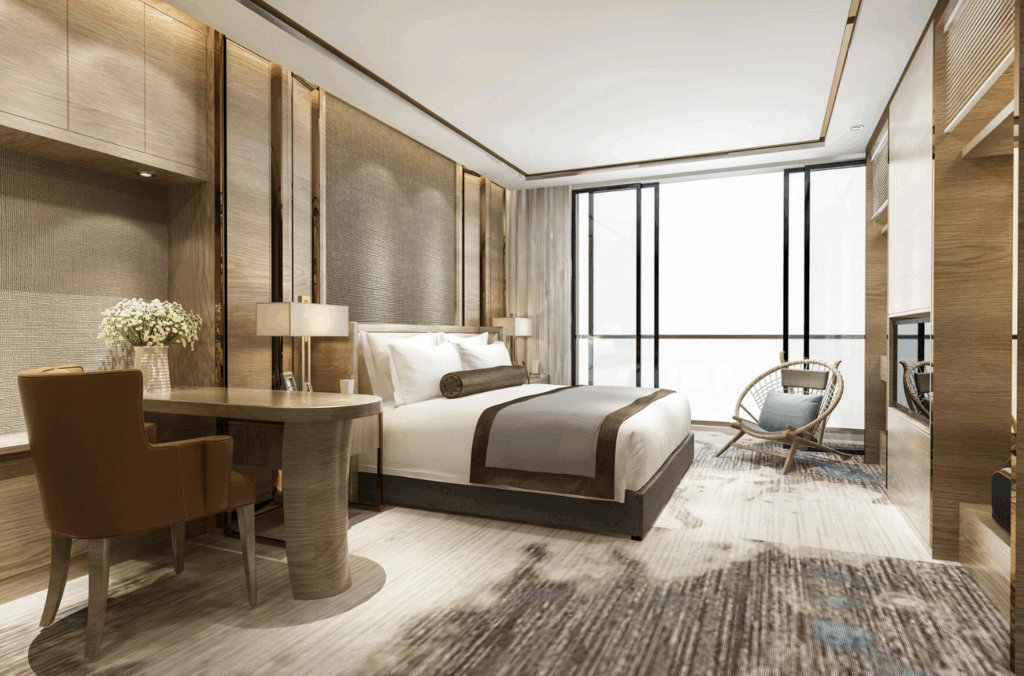
특화된 호스피탈리티 전문성 찾기
일반적인 카펫 공급업체를 뛰어넘어 다음 분야에서 풍부한 경험을 보유한 공급업체에 집중하세요. 호스피탈리티 등급 제품. 예를 들어, Dalton 호스피탈리티 카펫 밀스는 공장 직거래 가격을 제공하며 특히 호텔, 컨벤션 센터 및 레스토랑을 위한 서비스를 제공하며 로비에서 객실로의 전환에 대한 사례 연구도 제공합니다. 마찬가지로, Encore Hospitality Carpet과 Brintons는 사용량이 많은 환경을 위해 특별히 설계된 Axminster 및 혼합 카펫과 같은 제품군을 전문으로 합니다. 이 전문가들은 호텔의 교통 패턴, 음향 요구 사항 및 보증 기대치를 잘 이해하고 있습니다.
엔드투엔드 기능 우선순위 지정
이상적인 공급업체는 사내 디자인 및 염료 주입부터 생산 및 마감에 이르기까지 수직적으로 통합된 프로세스를 제공합니다. 예를 들어, Encore는 조지아 시설에서 생산 일정과 맞춤화 기능을 완벽하게 제어합니다. 로열 아메리칸 카펫도 마찬가지로 객실, 복도, 연회장 등에 맞춤화된 특수 기계를 제공하여 맞춤형 패턴과 색상 충실도를 대규모로 제공합니다.
리드 타임, 물류 및 최소값 평가
대규모 설치의 경우 다음 사항에 대한 명확한 설명이 필요합니다. 리드 타임, MOQ및 배송 물류. Rols(영국 소재)와 같은 회사는 최소 주문량(최소 100m²)에 대한 유연성을 제공하여 촉박한 리모델링 또는 단계적 출시에 이상적입니다. Dalton 및 Encore와 같은 다른 업체는 촉박한 프로젝트 일정을 맞추기 위해 빠른 배송과 대량 주문 프로세스를 강조합니다.
지속 가능성 자격 증명 확인
지속 가능성은 점점 더 중요한 우선 순위로 떠오르고 있습니다. 모호크, 인터페이스, 타이핑과 같은 시장 선도 기업들은 다음과 같이 지지하고 있습니다. 친환경 혁신-탄소 중립 카펫 타일부터 물을 사용하지 않는 염색 공정 및 고급 재활용 프로그램까지. 투명한 ESG 이니셔티브를 갖춘 제조업체를 선택하면 점점 높아지는 규제와 고객의 기대치를 충족할 뿐만 아니라 LEED 크레딧을 지원할 수 있습니다.
샘플, 사례 연구 및 사이트 참조 요청하기
항상 대형 카펫을 요청하세요 견본, 상세 기술 데이터 시트, 및 실제 세계 프로젝트 참조-유사한 숙박시설 유형에 설치된 샘플에 대한 보너스 포인트. 호스피탈리티 디자인의 공급업체 포털 및 이벤트 사례 연구(예: HD 엑스포)는 성능 주장을 검증하는 데 유용합니다.
보증 및 판매 후 지원 비교
강력한 보증은 마모, 견뢰도, 화재 안전 및 얼룩 처리에 대해 보장해야 합니다. 공급업체가 다음 사항도 제공하는지 확인하세요. 현장 지원, 유지보수 교육 및 교체 가능한 재고. Dalton과 같은 기업은 빠른 교체가 가능한 재고 및 제품 지식에 대한 액세스를 포함하여 공장 직접 이점을 강조합니다.
10. 호스피탈리티 카펫 유지보수
카펫의 성능은 일단 설치되면 유지 관리에 달려 있습니다. 사전 예방적 유지 관리 계획에는 다음이 포함됩니다:
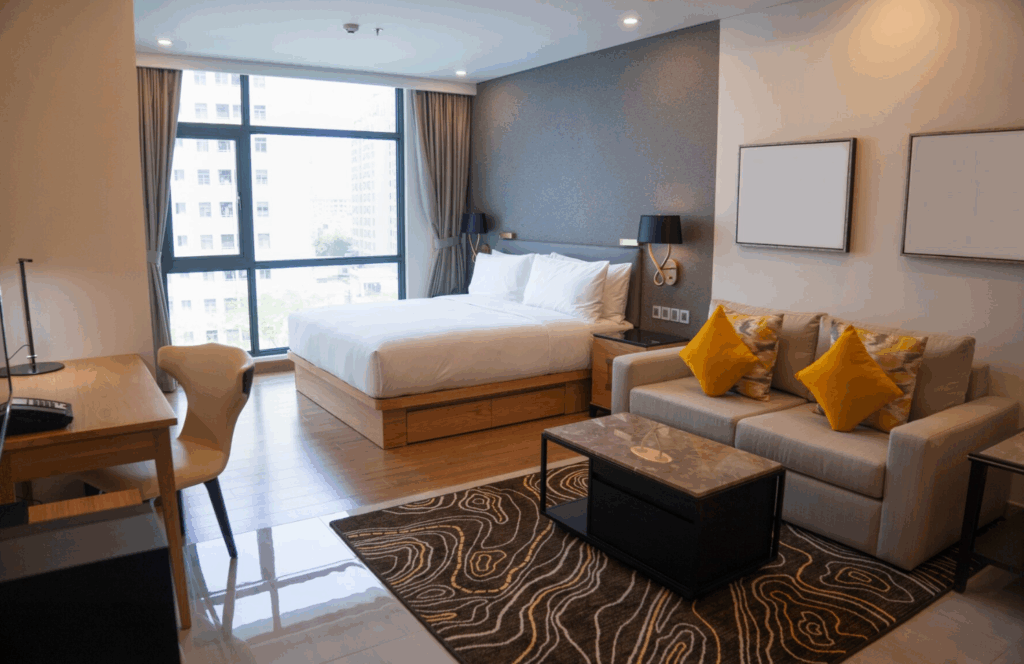
4단계 유지 관리 계획 수립
이 구조화된 접근 방식을 따라 호텔 카펫을 최상의 성능과 상태로 유지하세요:
- 예방 관리
- 고품질 입구 매트를 설치하여 카펫에 닿기 전에 최대 85%의 발에 묻은 흙을 가두세요.
- 실외 오염을 줄이기 위해 신발 금지 정책을 시행하거나 객실에 일회용 슬리퍼를 제공하세요.
- 일일 유지 관리
- 통행량이 많은 구역(로비, 복도, 엘리베이터)을 진공 청소기로 청소하세요. 매일, HEPA 필터 또는 비터 바가 장착된 상업용 진공청소기를 사용하여 미세먼지를 포집합니다.
- 얼룩이 굳지 않도록 문지르지 말고 즉시 얼룩을 닦아내고, 섬유 유형과 호환되는 업계 승인 솔루션을 사용하세요.
- 중간 및 저습 청소
- 1~3개월마다 보닛 캡슐화 또는 흡수성 파우더 청소와 같은 중간 처리를 수행하여 카펫을 적시지 않고 묻은 흙을 들어 올립니다.
- 제조업체 보증을 준수하는지 확인합니다. 일부 제조업체는 특정 저습 방법을 요구합니다.
- 복원 딥 클리닝
- 온수 추출(스팀 청소)을 매번 예약하세요. 3~6개월 트래픽이 많은 구역에서 적어도 격년 객실 내.
- 딥 클리닝은 알레르기 유발 물질을 제거하고, 외관을 되살리고, 섬유를 새로 고치고, 카펫 수명을 최대 50%까지 연장합니다.
모범 사례 및 직원 교육
- 영역별 일정 만들기: 로비의 매일 청소, 객실의 수시 점검, 회의장의 이벤트 후 청소 등 사용 빈도에 맞게 조정합니다.
- 올바른 장비 사용: 보증이 무효화되지 않도록 카펫 섬유와 호환되는 진공청소기와 청소기를 선택하세요.
- 저습도 기술 활용: 캡슐화가 잔여물을 포집하고 빠르게 건조(~20~30분)되어 가동 중단 시간을 줄여줍니다.
- 하우스키핑 직원 교육: 얼룩 발견 기술, 얼룩 식별, 화학물질 안전(MSDS 포함)에 대한 교육을 실시합니다. 규정 준수와 품질을 보장하기 위해 정기적으로 절차를 감사합니다.
- 문서 유지 관리 로그: 날짜, 청소 유형 및 모든 수리를 추적하세요. 이러한 로그는 보증 청구, 감사 및 성능 검토를 지원합니다.
유지보수 장비 및 소모품
- 진공 청소기: 높이와 비터 바를 조절할 수 있는 HEPA 필터가 장착된 업라이트 또는 백팩 진공청소기.
- 임시 관리 도구: 캡슐화 기계, 보닛 패드, 흡수성 카펫 파우더, 회전식 “로토클리너” 브러시를 사용하여 특정 부위를 청소할 수 있습니다.
- 딥 클리닝 시스템: IICRC 표준을 충족하는 상업용 온수 추출 장치.
- 얼룩 방지 처리: 청소 후 보호 코팅을 다시 도포하여 유출을 방지하고 얼룩 제거를 돕습니다. .
- 고품질 클리너: 보증 범위와 환경 무결성을 유지하려면 Green Seal, WoolSafe 또는 CRI 승인 솔루션을 사용하세요.
건강, 공기질 및 고객 만족도
- 정기적인 청소는 알레르겐과 오염 물질을 제거하여 실내 공기질을 개선하고 냄새, 천식, 알레르기에 대한 게스트의 불만을 줄이는 데 도움이 됩니다.
- 공공장소에서 눈에 보이는 유지보수를 통해 고객을 안심시키고 특히 팬데믹 이후 높은 수준의 위생 수준을 알릴 수 있습니다.
- 깨끗한 카펫은 더 좋은 첫인상을 남기고 만족도 점수가 높아지는 것과 상관관계가 있으므로 일관성 있는 카펫 관리는 세련된 고객 경험을 뒷받침합니다.
11. 결론
2025년의 호스피탈리티 카펫은 획일화된 솔루션이 아닙니다. 카펫은 실용성과 브랜드 스토리텔링이 결합되어 있어 기본적인 설비라기보다는 전략적 투자 대상입니다. 진화하는 기술, 화재 안전 혁신, 지속 가능한 디자인 옵션으로 인해 올바른 카펫을 선택하는 것이 그 어느 때보다 중요하고 복잡해졌습니다.
호텔리어와 디자이너는 카펫의 종류, 표준, 소싱 전략을 이해해야 기능뿐 아니라 기억에 남을 만한 결과를 얻을 수 있습니다. 호스피탈리티 업계에서는 바닥이 많은 것을 말해주기 때문입니다.
12. 자주 묻는 질문
1. 호텔 객실에 가장 적합한 카펫 유형은 무엇인가요?
터프프티드 카펫-비용 효율적이고, 발바닥이 부드럽고, 설치가 간편합니다.
2. 고급 호텔에서도 카펫 타일을 사용할 수 있나요?
예, 특히 모듈형 디자인이 유리한 로비나 회의실에서 유용합니다.
3. 호텔 카펫은 얼마나 자주 청소해야 하나요?
유동인구에 따라 3~6개월마다 매일 진공청소기와 정밀 청소를 실시합니다.
4. 모든 호텔 카펫은 내화성이 있나요?
상업용 등급으로 분류되려면 난연성 표준(예: ASTM D2859)을 충족해야 합니다.
5. 호텔 카펫의 수명은 어떻게 되나요?
사용 및 유지 관리 관행에 따라 일반적으로 7~15년입니다.

